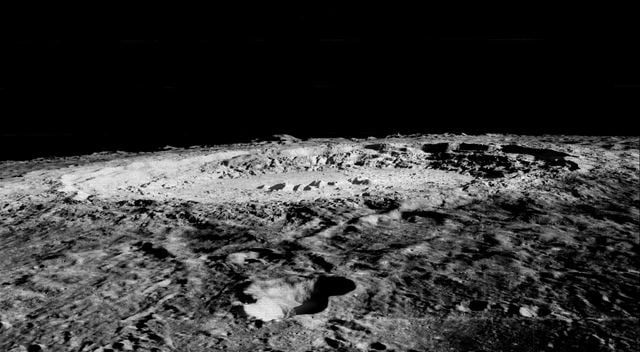It is now 50 years since astronauts last walked on the lunar surface, but the US National Aeronautics and Space Administration (NASA) and the European Space Agency (ESA) are planning new missions in the not too distant future. Some people are talking about using the Moon as a stopping-off point for missions further out into space.
For this reason, it is a problem that the Moon, unlike the Earth, does not have an atmosphere containing oxygen. In order to breathe on the Moon, we have to transport oxygen on the long and energy-consuming journey from Earth. That is, unless we can find a way of making the oxygen we need on the Moon itself.
“It is theoretically possible to make oxygen on the Moon”, says Karen Sende Osen, who is a Senior Research Scientist at SINTEF.
“The lunar surface is covered in sand composed of metals and oxygen”, says Olsen. “If we can extract the oxygen from this sand, it can be used by astronauts to breathe”, she says.
But that doesn’t make it an easy task.
“Very many of the technologies we might envisage using for this purpose have yet to be fully developed on Earth”, says Osen in a podcast (in Norwegian) that forms part of the series Smart forklart (Smart technology explained).
Click here to listen to the podcast: Making oxygen on the Moon (in Norwegian)
The Moon as a fuel stop
Karen Sende Osen does not believe that access to breathable air is the most important factor driving the development of oxygen extraction technologies.
“At least as important is the production of oxygen as a fuel for the vehicles that will be journeying out into space and using the Moon as a fuel stop”, she says.
It requires a lot of energy and fuel to escape the Earth’s gravitational field. An ability to power space vehicles with oxygen stored in fuel cells will make it possible to travel much farther distances.
“The Moon’s gravitational field is only one sixth the strength of the Earth’s, so much less fuel is needed to take off from the Moon”, explains Osen.
The Earth’s crust is also full of oxygen
Even though most of us think of oxygen mainly in connection with the air we breathe, there are in fact large volumes of the element contained in the ground beneath our feet. Oxygen is in fact the most abundant element, making up almost half (47 per cent) of the Earth’s crust.
On the Moon, the proportion is somewhat lower, but not by much. More than 40 per cent of the lunar crust is composed of oxygen.
This oxygen is bound up in minerals in combination with other elements as compounds called oxides. For example, quartz, or silicon dioxide (SiO2), is the second most common mineral in the Earth’s crust.
“When we separate a metal such as iron or silicon from an oxide on Earth, it’s because it is the metal itself we’re interested in”, says Osen. “Carbon is an excellent agent in the separation of oxygen from a metal, but the product is carbon dioxide (CO2). But we don’t want to produce any of this gas, at least not on the Moon”, she says.
Nor do we want any more CO2 on Earth than is absolutely necessary. So, any technology that might be developed for extracting oxygen from lunar sand will also be very relevant to us on Earth.
“Those of use conducting research into metals production are looking into how we can reduce CO2 emissions in connection with production processes, so we welcome any innovative approaches”, says Osen.
Electrolysis separates oxygen from metals
The process of separating oxygen from metals without producing CO2 is called electrolysis. In brief, the process involves using electricity to split the minerals into their individual components.
“Many metals are currently produced on Earth using a similar approach”, says Osen.
But, let us consider the lunar sand. This will first have to be placed in a liquid, called an electrolyte, which must then be heated to perhaps about 1,000 degrees. The sand will break down into electrically charged atoms called ions. A positive and negative electrode are then placed in the electrolyte and the ions will be attracted to their respective electrodes.
“The negatively charged oxygen atoms will move towards the positive electrodes where oxygen gas will be formed as the ions give up their electrons in response to the electric field.
Capturing the oxygen
However, even if oxygen gas starts bubbling up from one of the electrodes, we still have a big task ahead of us.
“Capturing this oxygen is a technology in itself”, says Osen. “And SINTEF has a lot of expertise in this field. We use a membrane, acting as a filter, in order to separate the different gases from each other”, she says.
“We are already conducting a great deal of research into this method in connection with fuel cell technology and CO2 capture, but a separate technology will have to be developed and adapted for lunar sand. It is certainly no off-the-shelf product”, says Osen.
So, there is a lot of research to be done before we can think of making breathable oxygen for use on the Moon. Both the filter needed to capture the oxygen and the electrode where the gas is formed have yet to be developed. And if that wasn’t enough, it is far from certain that what we can achieve on Earth can be replicated on the Moon.
“Conditions are very different on the lunar surface”, explains Osen. “For example, the lack of atmosphere means that there is a vacuum. A liquid electrolyte exposed in the open will evaporate very quickly and probably disappear – and much faster than here on Earth”, she says.
Lunar gravity is only one sixth of the strength of that on Earth. This may mean that both liquids and gases will behave very differently on the Moon.
“The Moon is also very hot during the day, with temperatures reaching as high as 200 degrees”, says Osen. “At night they can fall to as low as minus 100 degrees. These are extreme conditions that make things difficult, and there are many such challenges that make the situation demanding”, she says.

The Copernicus crater on the Moon may offer a source of oxygen both for breathing and for fuel used in vehicles travelling on missions further into space. Photo courtesy of NASA/JPL/USGS.
If we succeed
But if such technologies succeed, at least no lunar astronauts will experience any breathing problems.
“Twenty grammes of lunar sand contains enough oxygen to keep an astronaut alive for 20 minutes, and researchers have discovered that in some areas the sand layer is twelve metres deep, so there is no shortage of raw materials”, says Osen.
Given the right technology, the sand can also be used for other purposes, such as building materials.
“There are a lot of sand and rocks on the Moon, and a good deal of research is being conducted into making cement and concrete from the sand”, says Osen.
“There are also a number of areas where ice has been discovered, which it may also be possible to exploit, either by simply melting it, or by extracting the hydrogen and oxygen from the water”, she adds.
So even if lunar settlers cannot achieve full self-sufficiency, they will at least have come part of the way.
“It may be possible to build houses using concrete made on site”, says Osen. “If we succeed in making oxygen, it will be possible to use it both for breathing and as a fuel. There are also many metals contained in the sand, and it may be possible to exploit these in addition to the oxygen gas”, she says.
Not just science fiction
Osen admits that much of this may sound like science fiction. But, in the same way as the earlier Moon missions led to breakthroughs that have benefited human life on Earth, she believes that research being conducted into lunar sand may yield concrete results that everyone can be pleased about.
“Our team is working intensively on research into recycling, and in particular in the field of so-called urban mining, by which metals are recovered from scrap”, says Osen. “Many of these are what we call critical raw materials to which access is becoming limited and which also have great economic value”, she adds.
“The knowledge we are assembling about electrolysis processes and oxygen-free metal production can also be transferred indirectly to research that may be very useful to wider society here on Earth”, says Osen.
She is not allowing herself to be drawn into making estimates about when it might be possible to make oxygen on the Moon.
“On the basis of the technological challenges, which are many, we may perhaps hope that things may get off the ground in the next 20 to 30 years”, she says. “But this will very much depend on seeing some technological breakthroughs in the fields of materials production and gas capture”, says Osen.
Click here if you want to listen to the whole podcast in which Karen Sende Osen talks about lunar sand. Smart forklart – Slik kan vi lage oksygen på månen (Making oxygen on the Moon/in Norwegian).


